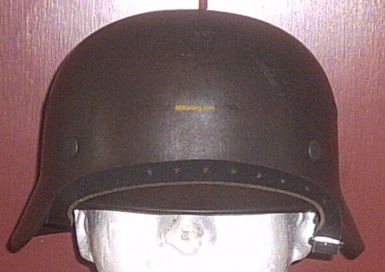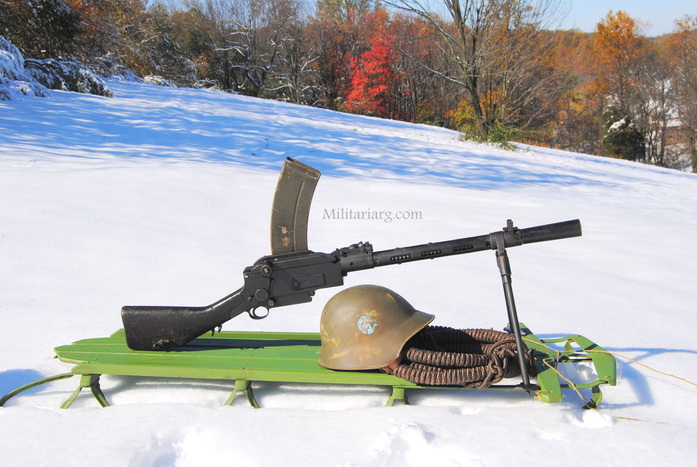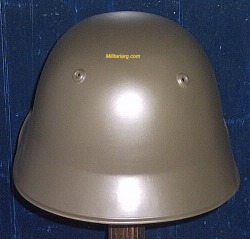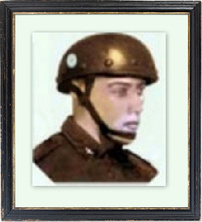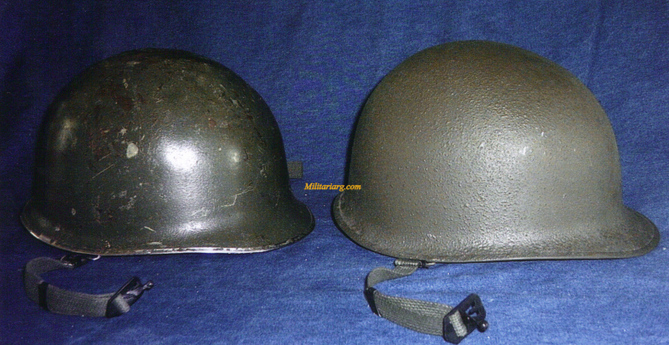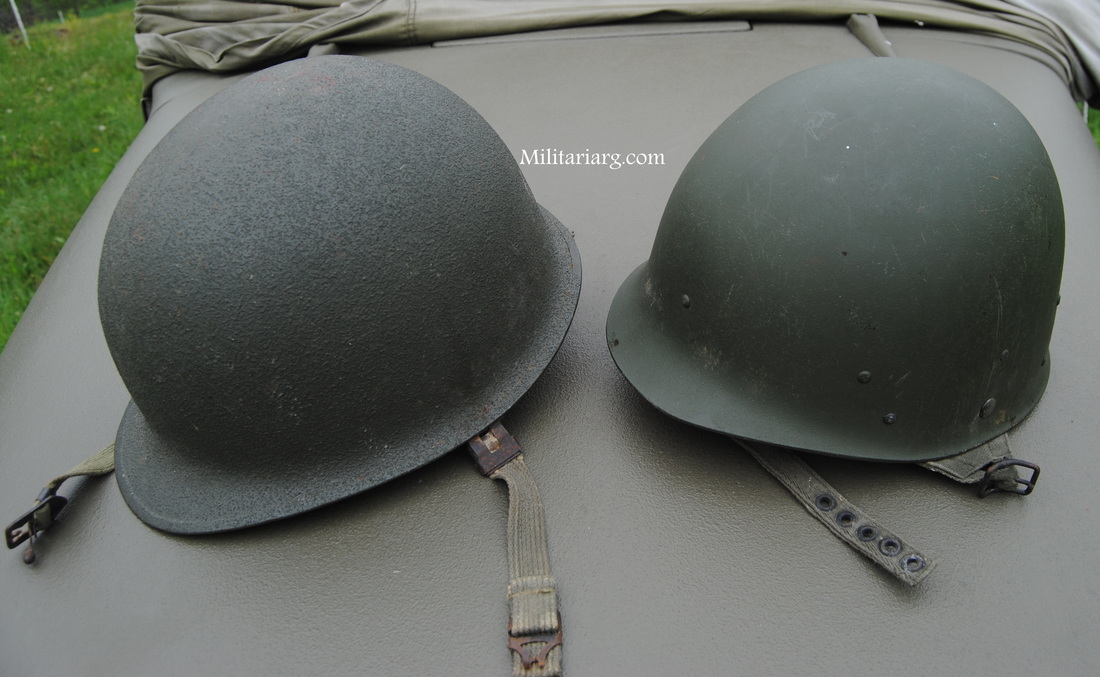Austrian Helmet M17
Authentic Austrian helmet M16/17 in brown factory color. This type of helmet was one of the first used by the Argentine military but did not gain wide acceptance.
German Helmet M35
Argentina copied the German style in a fiber-plastic for parades. However, some German steel helmets arrived in Argentina in the form of the M35/40. In the 1940s the Argentina Marine Infantry received a few hundred of these helmets. They may have come as part of a "package deal" along with the 20 Flak (Krupps) 88 cannons.
The image is an authentic German helmet from WWII reused by Czechoslovakia who painted it brown.
The image is an authentic German helmet from WWII reused by Czechoslovakia who painted it brown.
The first experimental steel helmets for modern war from the Helvetic Federation were designed by the painter and sculptor Charles L'Eplattenier and were based on designs from armor and wars of antiquity. There were a series of models not approved for serial production. The model that was finally approved on January 13, 1918 by the federal council was the design of Colonel Imboden. According to Bashord Dean (chairman of the Armor Committee of the American who supervised the development of the first experimental helmets in the US), in correspondance with Swiss designers, the project was by Dr Edward Gesser (directorial assistance of the Swiss National Museum in Zurich) and sculpor Paul Boesch (lieutenant in the Swiss High Command). Production first began in the Werker factory in Baden and later in the Metallwarenfabrik in Zug. It had 2 sizes, A and B. They weighed between 1220 and 1230 grams. The steek magnesium material wa 1.5mm thick and painted an olive green. They cost 22.50 Swiss francs per unit-a ton of money for the time! There was a lot of 10,000 helmets out of the 603,000 that were produced that went to Brazil in 1932. The models made until 1935 had a continuous liner band and the first models had an oval buckle on the chinstrap.
Left: Swiss M18. Right: US M2 Type Experimental Helmet.
1936. Presidents Roosevelt and Justo during the former's visit to Buenos Aires. Source Argentine Mauser Rifles 1871-1959 by Colin Webster.
Caras y Caretas 04/07/1936.
1937 Parade. Caras y Caretas
Maneuvers
1939. 6Th Infantry Regiment. Mercedes.
Swiss M18/38 ear cut-off (Cavalry Telephonist). 11Th Cavalry Regiment 1946.
Cavalry Regiment 11 (1946).
10th Hussars Rifle Regiment from the Pueyrredon Armored Cavalry w/ M18/40 helmets. Photo from Military Yearbook from 1960s.
M38 Helmet GN.
Gallery of M38 Collection
Above is a Swiss M18 army helmet (Argentina M38) covered in a dark olivie green.
Nice example of an M38 belonging to army shooting instructors.
Very rare Swiss/Argentine M18 battleship grey color with Navy badge. No Argentine helmet used the shield, however you can see M1 liners with shields from the Air Force and round national shields. In this case is a custom metal helmet with a soddered shield.
M18 Swiss Helmet from the National Gendarmerie. It comes in a lighter green than the Army green. The color is also used on the Gendarmerie's vehicles.
M18 Swiss Helmet from the Argentine Army Military Police.
M18 Swiss Helmet from the Argentine Police (Ex-Argentine Army).
Miscellaneous and Unusuals. Paint, camouflage scheme and decals
Photo: AP
Helmet Nets:
Short net for Tanker and Paratrooper Patterns
Left: ETM type W/Short Net. Right: NATO M1/Ar W/Long Net.
Shells models, chinstraps and liners.
This is the inside of a Swiss M18 helmet (Argentine M38). Observe that the Swiss helmets received in Argentina were the early version of the model. They have a circular liner band while the later M18-40 has a U-shaped band.
Above are the Swiss Model 18 helmets with M40 liner on the left and M63 on the right. Neither liner was used by the Argentine military.
Air Holes Vent, (Aeration System).
See the air hole rivets which are very similar to the Italian M33 helmet. The difference is that in the Swiss helmet there are only two in the rear and are solely for ventilation. In the Italian model the rivets also fasten to the liner band.
Swiss Camo covers
Above is a reversible camo cover for the M18 helmet used by the Swiss. The Argentine military did not adopt this system of camo, but rather used a netting system.
Paratrooper/Tanker Helmets
Marcelo Font Collection.
Malvinas campaign
Air Assault M1 Battlefield Relic.
WWII era, US liner, Argentine Navy circa 1948/82.
Anecdotes of the Helmet at War
Very nice and complete early WWII front seam, swivel bale US M1 helmet with Firestone liner. This old helmet, among those which were deployed on Normandy's beaches, returned to combat during the Malvinas War. It was found in the 1990s near where the Argentina's infantry took positions during the War.
During the Battle of Goose Green, where the disparity of forces was overwhelmingly in favor of the British, Estévez fought section A of the 2nd. British Parachute Battalion, which had about a hundred well-armed troops and naval support. In combat, which started at 5 in the morning lasted until almost 10, Estevez's section made three successive withdrawals and counterattacks.
During combat, Estévez patrolled the positions, shouting orders, under the British fire. When he left his trench he was shot twice, once in the arm and once on the left leg. Staggering, he reached the next trench. Estevez, who without worrying about his own wounds, asked a wounded and bleeding conscript named Sergio Daniel Rodriguez if he was alright, then took a FAL rifle and started shooting. Next he grabbed the radio and was giving new orders. There were five soldiers in the trench at the moment. Estévez, again without regard for his wounds, took the helmet of a dead Argentine soldier and placed it on Rodriguez's head to protect the soldier. At that time he received a new shot in the right cheek. Although they tried to help him, after saying a few words that could not be understood, he died. Subsequently, because Estevez was loaded with grenades, his body was pulled out of the hole. His body was shot several more times to the point of being almost unrecognizable. His grave, like that of many Argentine soldiers, is in the Darwin Cemetery in the Malvinas Islands.
Text taken from Wikipedia
Lieutenant Roberto Estévez - 25th Infantry Regiment (Argentina) Cross of Heroic Valour in Combat
During combat, Estévez patrolled the positions, shouting orders, under the British fire. When he left his trench he was shot twice, once in the arm and once on the left leg. Staggering, he reached the next trench. Estevez, who without worrying about his own wounds, asked a wounded and bleeding conscript named Sergio Daniel Rodriguez if he was alright, then took a FAL rifle and started shooting. Next he grabbed the radio and was giving new orders. There were five soldiers in the trench at the moment. Estévez, again without regard for his wounds, took the helmet of a dead Argentine soldier and placed it on Rodriguez's head to protect the soldier. At that time he received a new shot in the right cheek. Although they tried to help him, after saying a few words that could not be understood, he died. Subsequently, because Estevez was loaded with grenades, his body was pulled out of the hole. His body was shot several more times to the point of being almost unrecognizable. His grave, like that of many Argentine soldiers, is in the Darwin Cemetery in the Malvinas Islands.
Text taken from Wikipedia
Lieutenant Roberto Estévez - 25th Infantry Regiment (Argentina) Cross of Heroic Valour in Combat
M1-C Type Paratrooper Helmet. Second Lieutenant Oscar Augusto Silva who was killed in action in the Malvinas War.
Two Argentine helmets type US M1. The first, darker colored helmet was made in the US. The second was made in Argentina under the name "Modelo NATO". The difference between the 2 is that Argentine one has a longer visor.
Modelo NATO/OTAN.



